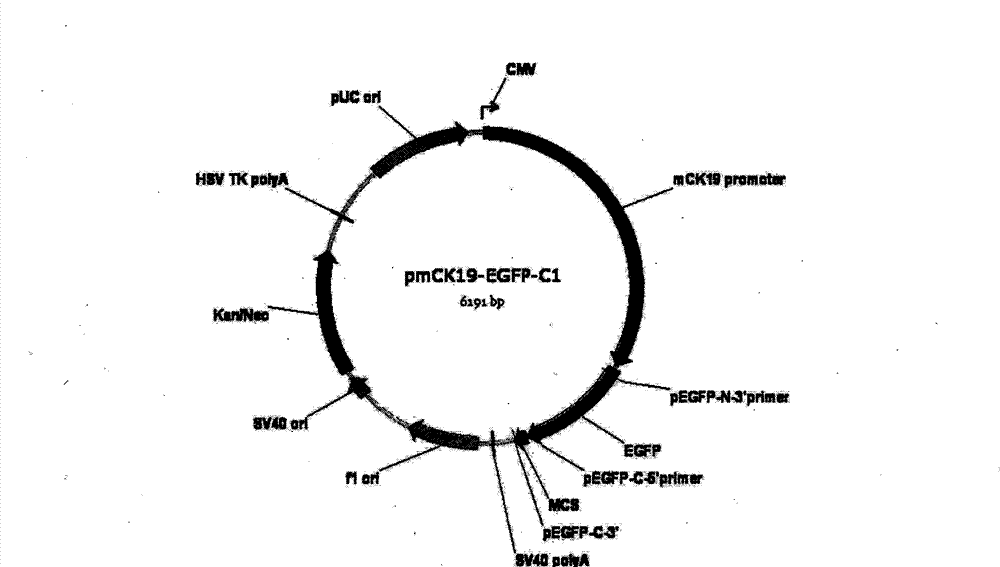Albumin/keratin double expression mice embryonic stem cell system and establishing method thereof
A mouse embryo and keratin technology, applied in the field of genetic engineering, can solve the problems of identifying the surface marker proteins of hepatic progenitor cells, difficulty in tracking and sorting hepatic progenitor cells, and inability to accurately demarcate hepatic progenitor cells, etc. Practical, simple effect
- Summary
- Abstract
- Description
- Claims
- Application Information
AI Technical Summary
Problems solved by technology
Method used
Image
Examples
Embodiment 1
[0053] Example 1 , carrier construction
[0054] 1.1. Construction of pcDNA3.1-mAlb-mRFP / hygro(-) vector
[0055] 1.1.1. Design the following PCR primers according to the sequence of plasmid pDB587 to amplify mRFP:
[0056] P1: 5'ACGCGGCCGCAGATCCACCATGGCCAGCTCCG3'
[0057] P2: 5'CTCAAGCTTTTAGCTTCCAGCGCCTGTGCTATGT3'
[0058] 1.1.2, PCR amplification
[0059] The plasmid pDB587 was used as a template, and P1 and P2 were used as primers for PCR amplification, as follows:
[0060] Reaction system (50 μl): 10×Buffer 5 μl, dNTP (100 μmol / L) 4 μl, MgSO 4 (50mM) 2μl, HIFI DNA polymerase 0.5μl, P1, P2 (10μM) each 1μl, ddH 2 O35.5 μl.
[0061] Reaction conditions: 94°C, 3min; 94°C 30sec, 62°C 30sec, 68°C 60sec, cycle 25 times; 72°C, 10min.
[0062] 1.1.3. Construction of pcDNA3.1-mRFP / hygro vector
[0063] The resulting PCR product was subjected to agarose gel electrophoresis, and the mRFP fragment of about 692 bp was recovered using a kit from QIAGEN, and double-digested with...
Embodiment 2
[0091] Example 2 , ALB and CK19 promoter tissue-specific expression
[0092] 2.1. Plasmid extraction
[0093] The four vectors constructed in Example 1 were used to extract the plasmids according to the instructions of the QIAGEN company's large extraction kit for future use.
[0094] 2.2. Cell transfection
[0095] The day before transfection, human liver cancer cells Huh7, mouse fibroblasts NIH-3T3, and human cholangiocarcinoma cells GBC-SD (all purchased from the Cell Bank of Shanghai Institute of Biochemistry and Cell Biology, Chinese Academy of Sciences) were spread on 6-well plates. When the cells grow to 60%-80% confluence, use the QIAGEN transfection kit to mix the plasmid obtained in step 2.1 with 8 μl enhancer, place at room temperature for 5 minutes, add transfection reagent and mix 5 times, place at room temperature for 8 minutes, and mix with Mix 1ml of the culture medium, and add it to the cell culture medium respectively as shown in Table 1. After 24-48 hour...
Embodiment 3
[0099] Example 3 , Establishment of mouse embryonic stem cell lines
[0100] 3.1. Plasmid linearization
[0101] Take 5 μg each of the vectors pcDNA3.1-mAlb-mRFP / hygro(-) and pcDNA3.1-mCK19-hCD25-IRES-tdTOMATO / hygro(-) constructed in Example 1, add 2 μl of Nru I, and digest overnight at 37°C ; Take 5 μg each of pmalb-EGFP-N2 and pmCK19-EGFP, add 2 μl of Apal I, and digest overnight at 37°C. Add 1 / 10 volume of sodium acetate to the obtained digested product and mix well, add 4 μl of DNAmate, 2.5 times the volume of -20°C ethanol, mix well, centrifuge at 13,000 rpm at 4°C for 15 minutes to obtain a white precipitate, dissolve it in sterile water for later use.
[0102] 3.2 Culture of mouse embryonic stem cells
[0103] Embryonic stem cells E14.1 (purchased from ATCC, deposit number CRL-1821) were cultured in a culture flask without a feeder layer but covered with 0.1% gelatin, and 10% KO-serum, 1% FBS, 100×P / S, 100× non-essential amino acids, 0.1mM β-mercaptoethanol, 1mM so...
PUM
 Login to View More
Login to View More Abstract
Description
Claims
Application Information
 Login to View More
Login to View More - R&D
- Intellectual Property
- Life Sciences
- Materials
- Tech Scout
- Unparalleled Data Quality
- Higher Quality Content
- 60% Fewer Hallucinations
Browse by: Latest US Patents, China's latest patents, Technical Efficacy Thesaurus, Application Domain, Technology Topic, Popular Technical Reports.
© 2025 PatSnap. All rights reserved.Legal|Privacy policy|Modern Slavery Act Transparency Statement|Sitemap|About US| Contact US: help@patsnap.com



